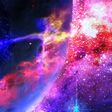
|
You may be looking for:
|
|
The Zerg Swarm is a terrifying and ruthless amalgamation of biologically advanced, arthropodal aliens. Dedicated to the pursuit of genetic perfection, the zerg relentlessly hunt down and assimilate advanced species across the galaxy, incorporating useful genetic code into their own.[2] They are named "the Swarm" per their ability to rapidly create strains, and the relentless assaults they employ to overwhelm their foes.[3]
Alongside the protoss and terrans, the zerg stand as one of the three dominant species of the Milky Way[4] and are universally feared, hated and hunted as such.[5] The Swarm in itself makes up a third of the power of the Koprulu Sector.[6] The zerg remain in areas of the galaxy outside the Koprulu sector.[7]
History
Creation of the Swarm
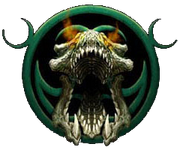
The Swarm's initial insignia
- Emil Narud(src)
Amon's xel'naga discovered the original zerg on Zerus.[8] The fallen xel'naga directly intervened in the zerg's development to gift them with the purity of essence, making them the counterparts of the protoss, gifted with the purity of form;[9] the zerg and protoss were intended to eventually merge to form a hybrid army for Amon.[10] At this point the zerg species diverged into two distinct branches; the Zerg Swarm that had been altered and the primal zerg that managed to avoid the tampering of Amon's xel'naga.[11] The xel'naga created the Overmind to control the zerg swarm and prevent a repeat of the protoss' Aeon of Strife. The Overmind oversaw the zerg swarm's rapid evolution, created the cerebrates, and divided the Swarm into broods.[2] The primal zerg, meanwhile, went into hiding to preserve their individuality.[12]
However, the xel'naga in Ulnar caught wind of Amon's plan, and sought to stop Amon from ending the Infinite Cycle. The two factions fought in the space above Zerus, and the swarm was released on the xel'naga. Most were slain and their knowledge was assimilated by the swarm.[8] Through this, the Overmind became aware of the existence of the protoss, and through them sought to make the Zerg Swarm perfect. However, it was aware of the directive implanted into it by Amon, and sought ways to subvert Amon's plans.[13]
The Great War

Having assimilated multiple species and evolved during the journey, the Swarm arrived at the Koprulu sector near the Protoss Empire. The Overmind ordered the assimilation of the terrans; their psionic potential was needed to fight the protoss. The protoss detected the zerg, learned of their xel'naga origins, and dispatched the Koprulu Expeditionary Force under Executor Tassadar to deny the zerg a foothold.[2]

The Queen of Blades
The Great War broke out with the zerg invasion of the terran worlds. Protoss purification, and terran internal strife, failed to contain the invasion. The terran rebel group, the Sons of Korhal, used and manipulated the invasion to overthrow the Terran Confederacy[14] and form the Terran Dominion.[15] The zerg captured Sarah Kerrigan at New Gettysburg[16] and withdrew to Char to transform her into the Queen of Blades.[17] The Overmind intended Kerrigan to succeed it as the Swarm's leader, freeing the zerg from Amon.[13] It had no concern over the other races of the galaxy.[18]

The zerg on Aiur
The zerg were attacked on Char by the protoss; a renegade Tassadar joined forces with Dark Prelate Zeratul on Char. Zeratul, wielding the Dark Templar's power of the Void, permanently slew Zasz. This created a brief mental link between Zeratul and the Overmind, through which the Overmind learned the exact location of Aiur.[19] Kerrigan remained on Char while the Swarm invaded Aiur.[20]
Resistance against the zerg invasion was hampered by the protoss Conclave's overconfidence and a short protoss civil war.[21] The planet was devastated.[22] The Overmind relocated to Aiur,[23] where it was slain by Tassadar.[24] The protoss subsequently withdrew to Shakuras, the Dark Templar homeworld.[25]
The Brood War
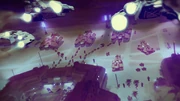
The UED Slave Broods
The Overmind's death left the Swarm divided between the cerebrate Daggoth and Kerrigan. Daggoth initiated creation of the second Overmind.[26] Kerrigan sought to kill the Overmind before it could mature and resume control over the entire Swarm and her.[27] The zerg civil war was complicated by the arrival of the United Earth Directorate Expeditionary Fleet in the Koprulu sector; the UED overthrew the Dominion,[28] and captured the second Overmind[29] with the intent of using the zerg to maintain control over the Sector.[22] The UED used the psi disrupter to fragment opposing zerg.[29]
Kerrigan manipulated both anti-UED terrans and the protoss to destroy the Psi Disrupter,[30] break UED control over the sector,[31] and slay the Overmind,[32] thus bringing the entire Swarm under her control.[33] Zerg betrayal dissolved the alliances of convenience.[32][34] The reformed Terran Dominion, UED remnants, and protoss attempted, and failed, to oust Kerrigan.[35] The war ended with all sides withdrawing to rebuild;[36] the zerg remained in control of previously infested worlds.[37]
Interbellum
For the next four years, the Swarm avoided outright conflict with the terrans and protoss while slowly expanding and evolving.[38][39] The remaining cerebrates died[38] and were replaced by broodmothers.[40]
As the first hybrids became active, signs of Amon's machinations reached Kerrigan.[41] While searching for clues about the hybrids, Zeratul discovered Kerrigan was essential to prevent the Swarm from fulfilling the Dark Voice's apocalyptic plans;[13] the dark templar instructed Commander Jim Raynor of Raynor's Raiders to ensure Kerrigan's survival.[42]
The Second Great War
The Second Great War began with the Swarm's invasion of terran space in search of a xel'naga device.[43] Various terran groups used the upheaval to their own ends. Raynor's Raiders fomented rebellion against the Terran Dominion[44] and, on behalf of Crown Prince Valerian Mengsk's Moebius Foundation, recovered the device before the Swarm.[45] A joint Raiders and Dominion attacked Char and used the device to restore Kerrigan to her terran form.[46] The Swarm fragmented.[47][48][49]
Kerrigan was doggedly pursued by the Dominion,[50][51] which led to Raynor's capture and reported execution by the Dominion. Kerrigan began reuniting the Swarm as a tool for vengeance, both for herself and for Raynor.[52] During this period, the Swarm journeyed to Zerus, where it was reunited with the primal zerg[53] and Kerrigan became a primal zerg-human hybrid.[54] Her new form was more powerful than the previous hybridization, and free of Amon's influence.[55]
The Swarm discovered and destroyed a secret Dominion hybrid production facility led by Doctor Emil Narud,[56] a servant of Amon. Kerrigan killed Narud, and learned of Amon's resurrection and the threat he posed to creation.[57] She directed the Swarm to wage war against Amon after killing Emperor Arcturus Mengsk.[58][59]
The campaign against the Dominion was a success. Raynor was found alive and rescued from a secret prison.[60] The Swarm invaded Korhal,[61][62][63] and Kerrigan personally entered the Korhal Palace and slew Mengsk. The Swarm departed Korhal to fight Amon.[64]
The End War
Zerg under Kerrigan's command assaulted a Moebius Foundation base whose personnel had come under the thrall of hybrids. It was successfully destroyed.[65] Afterwards Kerrigan sent the zerg toward Ulnar, but were engaged by Amon's hybrid.[66]
During the Reclamation of Aiur, the Daelaam fought what it thought was feral zerg on the surface of Aiur. However, these had fallen under the control of Amon's hybrid, and used tactics against the Daelaam.[67] As Amon rose and corrupted the Khala, Amon Brood pushed Hierarch Artanis's few remaining loyalists with the help of the hybrid and corrupted Khalai, forcing him to leave Aiur on the Spear of Adun.[68]
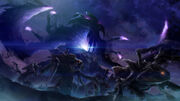
Amon then reactivated the warp gate linking Aiur to Shakuras, and sent billions of zerg to Shakuras. The Daelaam evacuated what population they could, but the planet had been infested.[69] In a last ditch move, Matriarch Vorazun ordered the xel'naga temple's phase prism overloaded, destroying Shakuras and all zerg on the surface.[70]
Kerrigan's swarm continued to battle at Ulnar, and were met with the Daelaam who helped her push into the Temple of Unification. They broke through Moebius Corps, Tal'darim and hybrid forces to get to the Chamber of Ascension,[66] but found the xel'naga inside dead. Amon revealed his trap, and opened a void portal.[71] The Zerg Swarm and Daelaam allied to destroy the void crystals powering the portal, but in the process Kerrigan's swarm took heavy casualties.[72]
The Daelaam once again came into conflict with Amon's zerg on the planet Endion, where the zerg infested the surface. The Daelaam pushed through their hives to activate the stasis locks keeping the Purifier station of Cybros in orbit, eventually clearing the hives.[73] However then the stasis lock fell Amon's zerg and hybrid descended on Cybros, and began to attempt to destroy the station's power core. However, the Daelaam activated the Purifiers, who cleansed the zerg from the platform, then purified the surface of Endion of all life, destroying the zerg infestation on the surface.[74]
Upon the Daelaam's return to Aiur, Amon's zerg made up the bulk of the defenses. They had infested Antioch and fought to defend the khaydarin crystals that powered the psionic matrix there, but were beaten back by Vorazun and Highlord Alarak. The zerg brought up heavy defenses for the last crystal as well, but a combined Daelaam force led by Artanis cut through them and destroyed the crystal.[75]
Amon's zerg served as part of his defensive line defending his host body, alongside shadows of the Void and corrupted Khalai protoss. These were no match for the Daelaam, who destroyed the host body.[76] Amon's brood then converged on the Daelaam as they prepared the Keystone to extract Amon from the Khala,[77] but even with the aid of the Golden Armada could not destroy the Keystone in time. Amon was pushed from the material universe.[78]

|
This article or section contains information derived from Co-op Missions, and should not be considered part of the official StarCraft storyline.
|
In spite of their weakened state, Kerrigan's Swarm was able to mobilize throughout the End War against Amon, winning several key victories under the leadership of Sarah Kerrigan, Zagara, Abathur, Alexei Stukov and Dehaka.[79]
Into the Void
On Ulnar, Kerrigan had managed to rebuild her broods, and sensed a benevolent voice calling to her from the Void. She gathered together the Dominion and the Daelaam, and the three factions pushed into the Void to end Amon and find out what voice was calling to them. They used the void portal in Ulnar to go into the Void,[80] but were attacked by shadows of the Void. They kept on the trail of the voice, and found it to be of Tassadar, who was imprisoned by Narud. Kerrigan and Alexei Stukov lead the zerg in the offense against Narud and his Void forces, and with the help of the Dominion and Daelaam pushed to Narud and weakened him. Stukov personally delivered the killing blow as revenge for killing him years earlier.[10]
Tassadar's voice revealed himself to be of Ouros, one of the last xel'naga, who said Kerrigan needed to ascend to a xel'naga in order to continue the Infinite Cycle and beat Amon.[81] Kerrigan began the process of absorbing Ouros's essence, but Amon sent shadows and void thrashers to stop the process. Zagara lead the swarm in the defense of their queen, and were aided by Raynor and Artanis. The transfer of essence was completed, and Kerrigan ascended to become a xel'naga. She stated that Zagara was now in charge of the swarm, and that she needed to remember the lessons Kerrigan had taught her.[82]
Kerrigan took her broods and directly engaged Amon, supported by the Terran Dominion and Daelaam. Her swarm destroyed the void crystals shielding him,[83] and Kerrigan delivered the killing blow against Amon. With Amon's fall, the swarm returned to the Koprulu sector.[84]
A New Queen
By 2508, the Zerg Swarm was unified under Broodmother Zagara.[84] This year, a ceasefire was declared between the Swarm, the Daelaam, and the Dominion.[1] She forcibly laid claim to Char and all of the surrounding worlds,[84] bringing the ceasefire into question.[85] Before Kerrigan departed from the swarm, she gave Zagara two gifts, one was the ability to choose the zerg's fate for themselves, to potentially lead them away from their warlike ways. The second was the location of creature that could house xel'naga essence. Zagara had what essence she could gathered from Ulnar, but there was only a limited amount.[86]
At some point, the zerg attacked a Umojan Protectorate expedition to Jarban Minor, infesting most of the research team.[87]
Years later a terran separatist group known as the Defenders of Man began planting psi-emitters on Dominion planets, prompting feral zerg to attack. The feral zerg struck Antiga Prime first,[88] then the colony of Bountiful. Emperor Valerian Mengsk affirmed to his people that the Dominion was not at war with the Zerg Swarm.[89] Each time, the Defenders of Man would arrive to repel the zerg, as a motion to show how weak the Dominion was in the face of an alien invasion.[89] Psi-emitters were planted on Borea, and the Dominion was forced to evacuate.[90] Finally, the feral zerg struck Tyrador IX in number when several psi-emitters were planted, but were attacked by the Tal'darim Death Fleet. After the Dominion defeated the Tal'darim, the Defenders of Man fleet sent to rescue the civilians defeated the feral zerg.[91]
By 2511, Zagara's experiments with fusing zerg and xel'naga essence had seen fruition. Under the direction of Abathur, the swarm created the adostra, a creature that could generate life on planets passively as the xel'naga did. Abathur however despised these creatures, and Zagara's peaceful stance, which he saw as contradictory to the Swarm's purpose of domination. In response, Abathur siphoned off some of the xel'naga essence, and instead made a breed named the chitha, zerg that could be verbally commanded and had a strong psionic presence that could disrupt communication and other psionic beings. He modified a queen named Mukav, and brought her to his side, and set about his plot to spark a new war.
Zagara used the adostra to regenerate the planet of Gystt, which had been purified in the Great War. The adostra turned the planet into a vibrant jungle, fresh with life. Soon the Daelaam arrived, seeking to purify the planet, so Zagara sent a message to Emperor Valerian Mengsk of the Terran Dominion asking for aid. He arrived, and she extended a hand of diplomacy, saying the Swarm had changed and that she would be willing to help the ailing factions rebuild their planets as she had Gystt. Though skeptical, Artanis and Valerian agreed to meet with her as long as they could survey the planet.
However, Abathur soon put his plans into motion, using his chitha to force the terrans and protoss to destroy two of the three adostra nests, hoping to respark hostilities. This enraged Zagara, but the three factions were able to intervene before the last nest was destroyed, hold off the chitha, and discover Abathur's plot. Zagara and the survey team slew Mukav and the remaining chitha, and incapacitated Abathur. Zagara refused to kill Abathur, but said he would be kept in a place where he could do no more harm.
With the One-Day War resolved and true war averted, peace talks began between the three factions, with the Swarm offering to aid in reconstruction efforts if they Daelaam and Dominion provided aid for them as well.[86]
During the Battle of Adena, the renegade broodmother Niadra revealed herself yet again, ambushing a terran group to gain enough biomass for her true purpose given by Kerrigan years ago: to destroy the protoss. The resulting skirmish killed many protoss and terrans, though Niadra's true prize, a terran psionic named Elms, escaped the planet. Meanwhile, on Gystt, Zagara sensed the appearance of Niadra, and pondered what it meant for the sector.[92]
Characteristics

- Maren Ayers(src)
A great deal of information has been ascertained as to the nature of zerg physiology and psychology, such as through the Terran Confederacy's Project Bellwood,[93] and the Terran Dominion's Project Blackstone.[94] All zerg breeds are efficient killers and/or possess abilities that will aid the Swarm in the destruction of its enemies.[2]
Physiology
- Maren Ayers(src)

A sample of zerg ionized tissue groups
The primal zerg maintain the genome of the zerg species before the creation of the Overmind.[95] After this, when the zerg deviated from their primal counterparts, the Swarm reduced their physical appearance to essential fighting components.[96] They excel in proliferation, per their high rate of reproduction.[97] The zerg as a whole are extremely tough, tenacious, and deadly. Their natural armor and weaponry is comparable to modern technology in terms of toughness and armor-piercing capabilities,[98] and their bone armor can take half a dozen gauss rifle rounds before breaking.[86] One-on-one, zerg are not as strong as their terran and protoss counterparts.[95] The zerg are extremely resistant to chemical agents,[98] but their biological nature still renders them vulnerable to concentrated radiation,[2] such as sigma radiation.[99]
All zerg strains are capable of operating in a variety of environments, and some can operate in the vacuum of space.[100] Most zerg are not adapted for space travel by themselves, but are carried by larger zerg such as leviathans. Space-borne zerg either have vast stores of oxygen or have been adapted to not require it,[101] while terrestrial strains are much less dependent on oxygen than other organic creatures, and take a very long time to suffocate.[102]
Zerg must eat and rest, but do not require extended hours of sleep and have no set periods of inactivity.[39] Left unchecked, zerg multiply at an alarming rate.[103] Zerg strains gain nutrients from creep, but can consume other animals for nourishment if the situation demands it.[104] By 2511, plantlife generated by the adostra provided a substitute for creep to provide sustenance for some zerg strains.[86] Zerg do not die of old age,[99] but zerg of the Swarm do age.[47]
Most zerg ground strains are also capable of burrowing and digging through virtually any surface, using groups of tiny muscles that vibrate at a low frequency and grind dirt and stone along their way, allowing them to "swim through the ground."[99] This ability made them extremely deadly in ambush situations, as many terran or protoss forces suffered losses when suddenly being surrounded by a mass of enemy zerg units.[105] All zerg ground strains move faster on creep than they do on normal ground due to microscopic filaments within the substance that allow them to 'skate' over it.[106] In a protracted fight, one of the Swarm's greatest battlefield advantages is their underground rapid transit system which they can excavate with amazing speed. During the Great War and Brood War, this was provided for by the nydus canal. As of the Second Great War, this has been supplanted by nydus worms, spawned by the nydus network.[95]
Zerg possess remarkable regenerative capabilities. Their alpha amino acids possess unique R groups that allow dead cell matter to be combined with normal proteins to create new cells. Under normal circumstances, zerg may regenerate indefinitely; a radically changing cell structure is a by-product of the process, as well as high quantity of energy in the process.[99] Given time, even a gravely wounded zerg will return to full health. Thus, a zerg colony remains viable if even one creature or structure survives.[2] Few zerg survive for more than a few minutes in a given battle, but those that do evolve during the battle itself, becoming more powerful every hour.[107] The zerg constantly study their enemies and adapt accordingly.[108] Zerg structures have the ability to adapt while under fire, hardening their outer shell with bony plates when under fire in order to ensure its survival.[109]
Zerg structures are essentially giant organs and draw sustenance from creep, a thick carpet-like substance that integrates a colony's structures as one macro-organism.[2] Compound B-5801 provides their structural basis.[110]
The zerg are obsessed with detecting subtler motions and more advanced camuflauge techniques.[111]
Genetics
Before hatching, a zerg specimen has two cell types in general: Type A creates random different mutations, while B cells hunt the new mutations. Upon hatching, the specimen of a certain strain is a result of the Darwin's theory of evolution on a cellular level; it is made of the strongest cell mutations that survived.[99]
Like terrans and protoss, zerg genetic material consists of DNA,[112] seemingly in the shape of a double helix.[105] However, when a zerg strain's DNA evolves, it becomes less flexible.[40] Apart from the overlord, every zerg strain ever encountered by terrans has been a custom mix of DNA, to the extent that no non-overlord strain bears much genetic resemblance to the organism(s) that spawned it. Dr. Talen Ayers theorized that the zerg are unwilling to too deeply alter the genetic makeup of organisms with psionic potential, as even the slightest of genetic changes can remove said potential. This would, in his mind, explain the genetic similarities in this case.[94]
The zerg like to pit themselves against harsh climates, using a planet's harsh conditions to further their own evolution.[113] In regards to assimilating the genetic material of other species, the zerg were initially very selective, assimilating only strong species at the top of their food chains and eradicating 'lesser species' lest they corrupt the purity of the zerg genome.[2] Under Kerrigan, the situation changed, and the zerg were willing to assimilate any material they came across.[113] The zerg genetic landscape is constantly changing, to the extent where using terms such as "mutant" (mutation being a permanent change to an organism's genetic code) can be considered to be a misnomer.[94]
Zerg DNA is "antithetical" to protoss DNA and they cannot infest protoss under normal conditions. In addition, protoss psionic powers (Khala and Void) protect the protoss.[114] The protoss are the only known species that the zerg have failed to assimilate.[115] However, their DNA can be artificially combined, creating hybrids.[114]
The following section contains information from StarCraft II: Wings of Liberty that is ambiguously canonical.
|
Hyper-rare mutant strains exist within the zerg gene pool.[116]
Psychology
- Colonel Ronald Jackson(src)

A hydralisk brain
It has been difficult for observers to determine the full extent of the zerg intelligence, but it is clear that they are a very cunning species, and they are capable of higher reasoning. Although they do not utilize technology, they demonstrate a clear understanding of it, and have been known to open airlocks and doorways in colonies that they have raided. As a group they also react intelligently to attacks and are adept at tactical combat. On an individual basis, though, the zerg seem to be hardly more than savage animals with little or no concern for self-preservation,[98] exhibiting no initiative.[95] Evolution is directed by "Alpha Zerg" strains, such as cerebrates and queens. Dr. Talise Cogan voiced the idea that the zerg, as a whole, can be considered to be a macro-organism.[94] The zerg can be considered to be a "slave race" to whatever entity controls them.[117] As a united body, zerg have been known to execute advanced combat tactics, setting up ambushes using burrowed units to disguise their ranks,[118] or using layered defensive lines like the infamous Juno lines to draw out armored columns.
Generally, communication between members of the Swarm is done through psionics, although higher command strains are able to process and understand vocal commands. After the End War, vocal and non-psionic communication became more commonly used by the Zerg Swarm.[86]
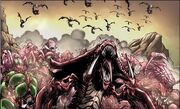
The zerg attacking en masse
For the zerg, success on the battlefield comes down to overwhelming numbers and great mobility. For them, war is simply survival of the fittest.[119] It is deemed mission critical by the Terran Dominion that zerg spawning centers be targeted as soon as tactically possible, for while the zerg can multiply at an alarming rate, their production of strains is centralized. Hence, the zerg will protect their hatcheries with fanatical zeal.[95]
The quest for perfection is rooted deep within the zerg psyche, and is a pseudo-religious concept for them. The core idea of this 'religion' is that there is a state that the zerg can reach where they would no longer need to evolve, that their evolutionary form would never have to change again because they could already adapt to any situation.[120]
Zerg have the ability to sense psychic power[121] and, being sensitive to it, often respond to it[122] (to the point of rendering themselves temporarily out of the control of a leader)[123] and seek it out.[124][125] This ability has a greater range than that of wranglers, weakly psychic terrans employed to find other psychics.[126]
In the rare cases the zerg's hive mind does communicate by a means terrans understand, they often refer to themselves as the "We." Those undergoing infestation are beckoned to be brought into their collective, welcoming them as the "Us."[127]
Control
The amount of control exerted over a zerg force also impacts on their intelligence.[2] Without this control, the zerg will become little more than animals, attacking everything on sight,[22] at times, even their own kind.[20] These zerg are referred to as feral zerg and can generally only operate at the lowest level.[128] In contrast, primal zerg are individuals, with no links to a hivemind.[54]
During the Brood War, the Queen of Blades became the uncontested leader of the Swarm. However, creating sapient lieutenants such as broodmothers extended her control over the Swarm even further.[129]
Zerg can be "lobotomized" to lose contact with the Zerg Swarm. The Terran Dominion conducted this experiment as early as 2500, using zerglings to seek psychic terrans.[126]
Warp Travel
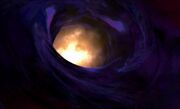
Zerg warp rift
The zerg are able to create rifts into warp space to transport themselves at faster-than-light speeds. These rifts have been utilized multiple times.[17][130]
Worlds
- Main article: Zerg worlds
The zerg have demonstrated an ability to storm worlds, but are less well-equipped at holding them. After the Brood War, the Swarm pulled back to Char, but could have easily expanded to cover numerous worlds again.[129] Over 100 worlds have been infested by the zerg.[131] Before they invade a planet, zerg fleets typically drop a massive payload of hive spores to seed the surface. Through the infestation process, the zerg can convert entire planetary bio-systems into extensions of their will.[95]
The following is a list of planets and moons that have been conquered by the Swarm, if only temporarily:
 Zerg on Tarsonis
|
Gameplay
General Notes
The zerg as a whole use large numbers of fast, weaker units that can be built or rebuilt quickly as long as they can establish a good starting economy, which can be one of their toughest challenges. They excel at attacking but are much weaker at defense than the protoss and terran factions. Gameplay with and against the zerg revolves heavily around their economy; if playing as them one needs to aggressively grow their economy faster than the enemy, and conversely when fighting the zerg one should either grow their own economy quickly to keep up or hamper the opponent's as much as possible.
StarCraft
StarCraft: Ghost
StarCraft II
Notes
- Many zerg breeds have a pair of mandibles on the sides of their mouths that can close together to form a mouthguard of sorts. Examples include the hydralisk, the lurker, and the queen. Most other breeds have some form of tusks or mandibles on or near their mouths. Dehaka, a primal zerg, also possesses these. Queens and broodmothers possess movable cheek mandibles, but do not have actual mouths.
- In the 2013–2018 period, the zerg article was the eighth most visited page on the wiki, narrowly losing out to the protoss (which took the #6 spot).[132]
- In the original StarCraft, the zerg unit sounds are meant to convey the sense of the zerg 'talking,' even though words aren't actually being said.[133]
Development
- Development notes on the zerg(src)
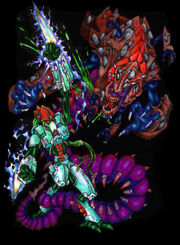
One of the earliest zerg (and protoss) concepts
- The original conception of the zerg in the StarCraft alpha had them named "Nightmarish Invaders" and later "zurg." This was later changed to "zerg" to avoid legal action from Pixar, as per the character of Emperor Zurg from Toy Story.[134]
- In the alpha, the zerg were a race of bio-mechanical creatures.[135] Samwise Didier has commented that the bio-mechanical idea has arguably come full circle as of StarCraft II, where by the end of the game, various infested mechanical units were used by the zerg[136] (such as the infested banshee).
- It was decided early on that the zerg would literally swarm their enemies.[137] They were originally conceieved as "teeth and feral rage; the dark side of evolution." Sharks were used as a point of reference in the original conception, taking flight to hunt humans from the sky.[138] The name "Nightmare Invaders" was retained for the freeware version of StarCraft: Loomings on its victory screen.[139]
- Alongside the terrans and protoss, the zerg aesthetic was decided early on in the development of StarCraft, that their structures would be spikey, almost triangular.[137] The triangular aspect came from Samwise Didier applying shape language theory to the three races, with the zerg structures being 'triangles,' the terrans' 'squares,' and protoss structures being elliptical.[136]
- The zerg were developed concurrently alongside the protoss.[138] However, the zerg underwent more revision than their counterpart in the original game; Blizzard frequently let its artists hold "jam sessions" to find the right look for the creatures. The hydralisk became the basis for the zerg after its reveal, namely that the zerg would be a purely organic race, with the look and feel being "hard chitinous plates and supple muscular flesh with lots of sharp points."[133]
- In the original game, most of the zerg sound effects were generated by Glenn Stafford.[137]
- During development of StarCraft: Brood War, a number of zerg concepts were developed. These were a mix of crustaceans, mammals, and "cat-looking things." During development of StarCraft II, the developers focused on the elements they liked, such as using overlapping plates and "adjusting the ratio of toothiness to glowing pustules to tentacle-y bits."[136]
Inspirations
- In terms of visual design, the zerg have drawn inspiration from many sources, ranging from other works of science fiction (such as the Alien series) to deep sea biology.[140] The prevailing science-fiction theme for the zerg (in terms of inspiration) was the idea of parasites assimilating their host.[136] Alien and Starship Troopers were among the most significant influences;[141] in the case of the latter, zerg standing-in for Arachnids in mods, assaulting fortified terran positions in a manner similar to the 1997 film, are very common.[142]
- Ender's Game has also been cited as an influence.[143]
- According to StarCraft concept artist Maxx Marshal, he had no knowledge of the Warhammer 40,000 franchise when designing the zerg (zerg have often been compared to the Tyranids), and based their designs off of his interest in comic books.[145] Similarly, Bob Fitch has stated that he had not heard of 40K until after StarCraft was shipped, after which a rumor began to circulate that StarCraft was based on the IP.[143]
- The zerg provided some of the inspiration for the Infernal Host faction in Stormgate,[146] and at least some of the inspiration for the grell in ZeroSpace.[147]
Design Process
According to Samwise Didier, the zerg design process can be summed up as follows:
- 1) You start with lots of teeth.
- 2) You choose a troop type
- a) Melee attacker
- b) Ranged attacker
- c) Flying attacker
- d) All of the above (game designers don't like this option, as it's too multi-purposed)
- 3) Pick a form
- a) Decapod
- b) Hexapod
- c) Octopod
- d) Serpentine
- 4) Add 2 or more of the following:
- a) Poisonous spines
- b) More teeth
- c) Barbed tails
- d) Jagged claws
- e) Spiked back plates
- f) Insectoid wings
- g) Venomous tendrils
- h) Bat wings
- i) Acidic glands
- j) A lot more teeth
- 5) Choose a name prefix:
- a) Rage
- b) Omega
- c) Spore
- d) Ravage
- e) Blade
- f) Destruct
- g) Terror
- h) Any other word that sounds violent and exudes overall nastiness.
- 6) Choose a suffix:
- a) -ling
- b) -list
- c) -tor
- d) -zor
- e) -etc.[115]
References
|
This page uses content from the English Wikipedia. The original content was at Zerg The list of authors can be seen in the page history of Zerg. Wikipedia content was licensed under the GNU Free Documentation License prior to June 15, 2009 is. Wikipedia content from June 15, 2009, and StarCraft Wiki content, is licensed under the Creative Commons Attribution-Share Alike License 3.0 (Unported). |
| Dominant Zerg faction | ||
|---|---|---|
| Preceded By | Duration | Succeeded By |
|
New creation |
?–06/2500 |
|
|
Incumbent (as Kerrigan's Swarm) | ||
| Dominant Koprulu faction | ||
|---|---|---|
| Preceded By | Duration | Succeeded By |
|
Incumbent? (concurrent with Terran Dominion) | ||
